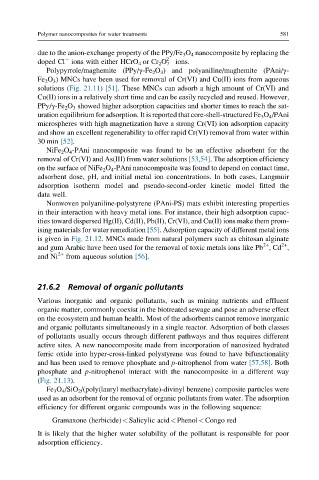Page 629 - Polymer-based Nanocomposites for Energy and Environmental Applications
P. 629
Polymer nanocomposites for water treatments 581
due to the anion-exchange property of the PPy/Fe 3 O 4 nanocomposite by replacing the
2
doped Cl ions with either HCrO 4 or Cr 2 O 7 ions.
Polypyrrole/maghemite (PPy/γ-Fe 2 O 3 ) and polyaniline/maghemite (PAni/γ-
Fe 2 O 3 ) MNCs have been used for removal of Cr(VI) and Cu(II) ions from aqueous
solutions (Fig. 21.11) [51]. These MNCs can adsorb a high amount of Cr(VI) and
Cu(II) ions in a relatively short time and can be easily recycled and reused. However,
PPy/γ-Fe 2 O 3 showed higher adsorption capacities and shorter times to reach the sat-
uration equilibrium for adsorption. It is reported that core-shell-structured Fe 3 O 4 /PAni
microspheres with high magnetization have a strong Cr(VI) ion adsorption capacity
and show an excellent regenerability to offer rapid Cr(VI) removal from water within
30 min [52].
NiFe 2 O 4 -PAni nanocomposite was found to be an effective adsorbent for the
removal of Cr(VI) and As(III) from water solutions [53,54]. The adsorption efficiency
on the surface of NiFe 2 O 4 -PAni nanocomposite was found to depend on contact time,
adsorbent dose, pH, and initial metal ion concentrations. In both cases, Langmuir
adsorption isotherm model and pseudo-second-order kinetic model fitted the
data well.
Nonwoven polyaniline-polystyrene (PAni-PS) mats exhibit interesting properties
in their interaction with heavy metal ions. For instance, their high adsorption capac-
ities toward dispersed Hg(II), Cd(II), Pb(II), Cr(VI), and Cu(II) ions make them prom-
ising materials for water remediation [55]. Adsorption capacity of different metal ions
is given in Fig. 21.12. MNCs made from natural polymers such as chitosan alginate
2+
2+
and gum Arabic have been used for the removal of toxic metals ions like Pb ,Cd ,
and Ni 2+ from aqueous solution [56].
21.6.2 Removal of organic pollutants
Various inorganic and organic pollutants, such as mining nutrients and effluent
organic matter, commonly coexist in the biotreated sewage and pose an adverse effect
on the ecosystem and human health. Most of the adsorbents cannot remove inorganic
and organic pollutants simultaneously in a single reactor. Adsorption of both classes
of pollutants usually occurs through different pathways and thus requires different
active sites. A new nanocomposite made from incorporation of nanosized hydrated
ferric oxide into hyper-cross-linked polystyrene was found to have bifunctionality
and has been used to remove phosphate and p-nitrophenol from water [57,58]. Both
phosphate and p-nitrophenol interact with the nanocomposite in a different way
(Fig. 21.13).
Fe 3 O 4 /SiO 2 /(poly(lauryl methacrylate)-divinyl benzene) composite particles were
used as an adsorbent for the removal of organic pollutants from water. The adsorption
efficiency for different organic compounds was in the following sequence:
Gramaxone (herbicide)<Salicylic acid<Phenol<Congo red
It is likely that the higher water solubility of the pollutant is responsible for poor
adsorption efficiency.

